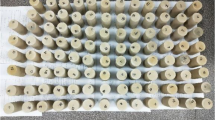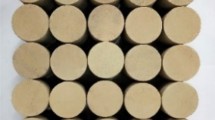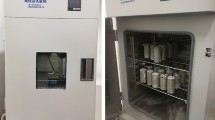Abstract
Freeze–thaw (FT) damage and deformation of porous rocks would affect the normal operation or even threaten the safety of rock engineering in cold regions. During the FT process, pore ice pressure induced by temperature variation and phase change of pore water/ice would exceed the yield strength of rocks accompanied by the occurrence of plastic strain. Therefore, an effort that couples thermal mechanism and elastoplastic mechanical process is performed in the study to further understand the deformation process of porous rocks under FT condition. First, experiments on FT deformation of saturated sandstone with different freezing temperature are conducted. Four stages are observed in deformation variation process: thermal contraction stage, frost heaving stage for the freezing process, and thawing shrinkage stage, thermal expansion stage for the thawing process. Besides, significant residual strain remains after FT experiments implying the occurrence of irrecoverable plastic strain. Then, a thermal–mechanical coupling elastoplastic model of FT deformation for porous rocks is proposed, which couples the governing equations of heat transfer considering unfrozen water content and mechanical equilibrium equations based on the poro-elastoplastic approach. Comparisons between the results of thermal–mechanical numerical simulation based on the model and the experimental results show that the model can predict the temperature variation and FT deformation process of porous rocks with desirable accuracy. Moreover, as exhibited in the numerical results, during the freezing process, pore ice pressure increases dramatically as temperature decreases from 0 to − 5 ℃. The plastic region generates at about − 2 ℃, and its increase rate is greater when the temperature is between − 2 and − 5 ℃. During the thawing process, although pore ice pressure eliminates in the region where the temperature becomes positive, the frost heaving strain there is not completely recovered as the plastic residual strain remains, which is consistent with the experimental phenomenon.
Highlights
-
A thermal-mechanical coupling elastoplastic model of freeze-thaw deformation for porous rocks is proposed.
-
The model couples the governing equations of heat transfer and equilibrium equations with poro-mechanics.
-
Experiments on freeze-thaw deformation of porous sandstone are conducted.















Similar content being viewed by others
Abbreviations
- \(\omega\) :
-
Unfrozen water content of porous rocks
- \(\omega^{ * }\) :
-
Residual unfrozen water content at a reference temperature
- \(T\) :
-
Temperature
- \(T_{0}\) :
-
Freezing point
- \(C\) :
-
Volumetric thermal capacity of porous rocks
- \(\lambda_{ef}\) :
-
Effective thermal conductivity of porous rocks
- \(L\) :
-
Specific latent heat of pore water
- \(\rho_{w}\) :
-
Density of pore water
- \(\theta_{w}\) :
-
Volumetric unfrozen water content of porous rocks
- \(\theta_{i}\) :
-
Volumetric ice content of porous rocks
- \(n_{0}\) :
-
Initial porosity of rock
- \(d_{s}\) :
-
Specific gravity of rock
- \(C_{s}\) :
-
Volumetric thermal capacity of sandstone grains
- \(C_{w}\) :
-
Volumetric thermal capacity of pore water
- \(C_{i}\) :
-
Volumetric thermal capacity of pore ice
- \(\lambda_{s}\) :
-
Thermal conductivity of sandstone grains
- \(\lambda_{w}\) :
-
Thermal conductivity of pore water
- \(\lambda_{i}\) :
-
Thermal conductivity of pore ice
- \(P_{i}\) :
-
Pore ice pressure at the interface of pore and rock matrix
- \(K_{i}\) :
-
Bulk modulus of pore ice
- \(\alpha_{T}\) :
-
Thermal expansion coefficient
- \(G_{m}\) :
-
Shear modulus of rock matrix
- \(K_{m}\) :
-
Bulk modulus of rock matrix
- \(\sigma_{0}\) :
-
Tensile strength of rock matrix
- \(R_{V}\) :
-
Volume ratio the plastic zone and the pore
- \(\varepsilon_{t}\) :
-
Total freezing strain of porous rocks
- \(\varepsilon_{f}\) :
-
Frost heaving strain of porous rocks
- \(\varepsilon_{T}\) :
-
Thermal strain of porous rocks
- \({\mathbf{C}}\) :
-
Fourth-order tensor of material stiffness
- \({\varvec{\varepsilon}}_{el}\) :
-
Elastic strain tensor
- \({\varvec{\varepsilon}}_{inel}\) :
-
Initial and inelastic strains
- \({\varvec{\varepsilon}}_{0}\) :
-
Initial strain tensor
- \({\varvec{\varepsilon}}_{T}\) :
-
Thermal strain tensor
- \({\varvec{\varepsilon}}_{ft}\) :
-
Frost heaving strain tensor
- \(\varepsilon_{re}\) :
-
Residual strain during the thawing process
- \(P_{u}\) :
-
Unloading pressure during the thawing process
References
Akagawa S, Fukuda M (1991) Frost heave mechanism in welded tuff. Permafrost Periglac Process 2:301–309. https://doi.org/10.1002/ppp.3430020405
Boukpeti N (2008) One-dimensional analysis of a poroelastic medium during freezing. Int J Numer Anal Meth Geomech 32:1661–1691. https://doi.org/10.1002/nag.689
Chen TC, Yeung MR, Mori N (2004) Effect of water saturation on deterioration of welded tuff due to freeze-thaw action. Cold Reg Sci Technol 38:127–136. https://doi.org/10.1016/j.coldregions.2003.10.001
Coussy O (2005) Poromechanics of freezing materials. J Mech Phys Solids 53:1689–1718. https://doi.org/10.1016/j.jmps.2005.04.001
Coussy O, Monteiro P (2007) Unsaturated poroelasticity for crystallization in pores. Comput Geotech 34:279–290. https://doi.org/10.1016/j.compgeo.2007.02.007
Dormieux L, Kondo D, Ulm F-J (2006) Microporomechanics. Wiley, Chichester
Duca S, Alonso EE, Scavia C (2015) A permafrost test on intact gneiss rock. Int J Rock Mech Min Sci 77:142–151. https://doi.org/10.1016/j.ijrmms.2015.02.003
Eslami J, Walbert C, Beaucour A-L et al (2018) Influence of physical and mechanical properties on the durability of limestone subjected to freeze-thaw cycles. Constr Build Mater 162:420–429. https://doi.org/10.1016/j.conbuildmat.2017.12.031
Fan L, Xu C, Wu Z (2020) Effects of cyclic freezing and thawing on the mechanical behavior of dried and saturated sandstone. Bull Eng Geol Environ 79:755–765. https://doi.org/10.1007/s10064-019-01586-z
Fen-Chong T, Fabbri A, Thiery M, Dangla P (2013) Poroelastic analysis of partial freezing in cohesive porous materials. J Appl Mech 80:020910.
Hashemi M, Bashiri Goudarzi M, Jamshidi A (2018) Experimental investigation on the performance of Schmidt hammer test in durability assessment of carbonate building stones against freeze–thaw weathering. Environ Earth Sci 77:684. https://doi.org/10.1007/s12665-018-7874-8
Huang S, Lu Z, Ye Z, Xin Z (2020) An elastoplastic model of frost deformation for the porous rock under freeze-thaw. Eng Geol 278:105820. https://doi.org/10.1016/j.enggeo.2020.105820
Huang S, Cai Y, Liu Y, Liu G (2021a) Experimental and theoretical study on frost deformation and damage of red sandstones with different water contents. Rock Mech Rock Eng 54:4163–4181. https://doi.org/10.1007/s00603-021-02509-9
Huang S, Xin Z, Ye Y, Liu F (2021b) Study on the freeze–thaw deformation behavior of the brittle porous materials in the elastoplastic regime based on Mohr-Coulomb yield criterion. Constr Build Mater 268:121799. https://doi.org/10.1016/j.conbuildmat.2020.121799
Jamshidi A (2021) Predicting the strength of granitic stones after freeze–thaw cycles: considering the petrographic characteristics and a new approach using petro-mechanical parameter. Rock Mech Rock Eng 54:2829–2841. https://doi.org/10.1007/s00603-021-02458-3
Jamshidi A, Nikudel M, Khamehchiyan M (2013) Predicting the long-term durability of building stones against freeze–thaw using a decay function model. Cold Reg Sci Technol 92:29–36. https://doi.org/10.1016/j.coldregions.2013.03.007
Jamshidi A, Nikudel M, Khamehchiyan M (2015) Estimating the engineering properties of building stones after freeze-thaw using multiple regression analysis. Iran J Sci Technol Trans A-Sci 39:147–163
Jia H, Zi F, Yang G et al (2019) Influence of pore water (ice) content on the strength and deformability of frozen argillaceous siltstone. Rock Mech Rock Eng. https://doi.org/10.1007/s00603-019-01943-0
Li X, Qu D, Luo Y et al (2019) Damage evolution model of sandstone under coupled chemical solution and freeze-thaw process. Cold Reg Sci Technol 162:88–95. https://doi.org/10.1016/j.coldregions.2019.03.012
Liu L, Qin S, Wang X (2018) Poro-elastic–plastic model for cement-based materials subjected to freeze–thaw cycles. Constr Build Mater 184:87–99. https://doi.org/10.1016/j.conbuildmat.2018.06.197
Liu L, Qin G, Qin S, Tao G (2020a) Simulation of the volumetric deformation and changes in the pore structure of unsaturated cement-based materials subjected to freezing/thawing. Constr Build Mater 230:116964. https://doi.org/10.1016/j.conbuildmat.2019.116964
Liu Y, Cai Y, Huang S et al (2020b) Effect of water saturation on uniaxial compressive strength and damage degree of clay-bearing sandstone under freeze-thaw. Bull Eng Geol Environ 79:2021–2036. https://doi.org/10.1007/s10064-019-01686-w
Lv Z, Xia C, Li Q (2018) Experimental and numerical study on frost heave of saturated rock under uniform freezing conditions. J Geophys Eng 15:593–612. https://doi.org/10.1088/1742-2140/aa93ac
Lv Z, Xia C, Li Q, Si Z (2019a) Empirical frost heave model for saturated rock under uniform and unidirectional freezing conditions. Rock Mech Rock Eng 52:955–963. https://doi.org/10.1007/s00603-018-1666-z
Lv Z, Xia C, Wang Y, Luo J (2019b) Analytical elasto-plastic solution of frost heaving force in cold region tunnels considering transversely isotropic frost heave of surrounding rock. Cold Reg Sci Technol 163:87–97. https://doi.org/10.1016/j.coldregions.2019.04.008
Martínez-Martínez J, Benavente D, Gomez-Heras M et al (2013) Non-linear decay of building stones during freeze–thaw weathering processes. Constr Build Mater 38:443–454. https://doi.org/10.1016/j.conbuildmat.2012.07.059
Matsuoka N (1990) Mechanisms of rock breakdown by frost action: an experimental approach. Cold Reg Sci Technol 17:253–270
Michalowski RL, Zhu M (2006) Frost heave modelling using porosity rate function. Int J Numer Anal Meth Geomech 30:703–722
Murton JB, Ozouf J-C, Peterson R (2016) Heave, settlement and fracture of chalk during physical modelling experiments with temperature cycling above and below 0°C. Geomorphology 270:71–87. https://doi.org/10.1016/j.geomorph.2016.07.016
Park J, Hyun C-U, Park H-D (2015) Changes in microstructure and physical properties of rocks caused by artificial freeze–thaw action. Bull Eng Geol Environ 74:555–565. https://doi.org/10.1007/s10064-014-0630-8
Prick A (1995) Dilatometrical behaviour of porous calcareous rock samples subjected to freeze-thaw cycles. CATENA 25:7–20. https://doi.org/10.1016/0341-8162(94)00038-G
Prick A (1997) Critical degree of saturation as a threshold moisture level in frost weathering of limestones. Permafrost Periglac Process 8:91–99. https://doi.org/10.1002/(SICI)1099-1530(199701)8:1%3c91::AID-PPP238%3e3.0.CO;2-4
Rusin Z, Świercz P (2017) Frost resistance of rock materials. Constr Build Mater 148:704–714. https://doi.org/10.1016/j.conbuildmat.2017.04.198
Huang S, Liu Q, Liu Y et al (2018) Freezing strain model for estimating the unfrozen water content of saturated rock under low temperature. Int J Geomech 18:04017137. https://doi.org/10.1061/(ASCE)GM.1943-5622.0001057
Takarli M, Prince W, Siddique R (2008) Damage in granite under heating/cooling cycles and water freeze–thaw condition. Int J Rock Mech Min Sci 45:1164–1175. https://doi.org/10.1016/j.ijrmms.2008.01.002
Tan X, Chen W, Yang J, Cao J (2011) Laboratory investigations on the mechanical properties degradation of granite under freeze–thaw cycles. Cold Reg Sci Technol 68:130–138. https://doi.org/10.1016/j.coldregions.2011.05.007
Tan X, Chen W, Wu G, Yang J (2013) Numerical simulations of heat transfer with ice–water phase change occurring in porous media and application to a cold-region tunnel. Tunn Undergr Space Technol 38:170–179. https://doi.org/10.1016/j.tust.2013.07.008
Tan X, Chen W, Liu H et al (2018) A unified model for frost heave pressure in the rock with a penny-shaped fracture during freezing. Cold Reg Sci Technol 153:1–9. https://doi.org/10.1016/j.coldregions.2018.04.016
Walbert C, Eslami J, Beaucour A-L et al (2015) Evolution of the mechanical behaviour of limestone subjected to freeze–thaw cycles. Environ Earth Sci 74:6339–6351. https://doi.org/10.1007/s12665-015-4658-2
Wang L, Li N, Qi J et al (2019) A study on the physical index change and triaxial compression test of intact hard rock subjected to freeze-thaw cycles. Cold Reg Sci Technol 160:39–47. https://doi.org/10.1016/j.coldregions.2019.01.001
Winkler EM (1968) Frost damage to stone and concrete: geological considerations. Eng Geol 2:315–323. https://doi.org/10.1016/0013-7952(68)90010-0
Yu H-S (2000) Cavity Expansion Methods in Geomechanics. Springer Science+Business Media, Berlin, Heidelberg.
Zeng Q, Fen-Chong T, Li K-F (2013) Elastic behavior of saturated porous materials under undrained freezing. Acta Mech Sin 29:827–835. https://doi.org/10.1007/s10409-013-0082-6
Zhang Y, Michalowski RL (2015) Thermal-hydro-mechanical analysis of frost heave and thaw settlement. J Geotech Geoenviron Eng 141:04015027. https://doi.org/10.1061/(ASCE)GT.1943-5606.0001305
Zhang H, Meng X, Yang G (2020) A study on mechanical properties and damage model of rock subjected to freeze-thaw cycles and confining pressure. Cold Reg Sci Technol 174:103056. https://doi.org/10.1016/j.coldregions.2020.103056
Acknowledgements
This research was supported by the National Natural Science Foundation of China (52108370) and Jiangxi Provincial Natural Science Foundation (No. 20212BAB214062).
Author information
Authors and Affiliations
Contributions
ZL: funding acquisition, writing—original draft and methodology. SL: data curation and validation. CX: formal analysis and investigation. XZ: conceptualization; writing—review & editing.
Corresponding author
Ethics declarations
Conflict of interest
The authors declare that there is no conflict of interest exits in the submission of this manuscript, and manuscript is approved by all authors for publication.
Additional information
Publisher's Note
Springer Nature remains neutral with regard to jurisdictional claims in published maps and institutional affiliations.
Rights and permissions
About this article
Cite this article
Lv, Z., Luo, S., Xia, C. et al. A Thermal–Mechanical Coupling Elastoplastic Model of Freeze–Thaw Deformation for Porous Rocks. Rock Mech Rock Eng 55, 3195–3212 (2022). https://doi.org/10.1007/s00603-022-02794-y
Received:
Accepted:
Published:
Issue Date:
DOI: https://doi.org/10.1007/s00603-022-02794-y




